HC Verma Physics books are the most preferred books among students of CBSE schools. Students can be found referring to the chapters as well as practice questions at the end of each of these chapters, in the books. Students follow these textbooks religiously since quite a few questions in these also appear in exams.
Contents
- 1 HC Verma Solutions for Class 12 Physics Chapter 34 – Magnetic Field
- 1.0.1 Page No 228:
- 1.0.2 Question 1:
- 1.0.3 Answer:
- 1.0.4 Page No 229:
- 1.0.5 Question 2:
- 1.0.6 Answer:
- 1.0.7 Question 3:
- 1.0.8 Answer:
- 1.0.9 Question 4:
- 1.0.10 Answer:
- 1.0.11 Question 5:
- 1.0.12 Answer:
- 1.0.13 Question 6:
- 1.0.14 Answer:
- 1.0.15 Question 7:
- 1.0.16 Answer:
- 1.0.17 Question 8:
- 1.0.18 Answer:
- 1.0.19 Question 9:
- 1.0.20 Answer:
- 1.0.21 Question 10:
- 1.0.22 Answer:
- 1.0.23 Question 1:
- 1.0.24 Answer:
- 1.0.25 Question 2:
- 1.0.26 Answer:
- 1.0.27 Question 3:
- 1.0.28 Answer:
- 1.0.29 Question 4:
- 1.0.30 Answer:
- 1.0.31 Question 5:
- 1.0.32 Answer:
- 1.0.33 Question 6:
- 1.0.34 Answer:
- 1.0.35 Question 7:
- 1.0.36 Answer:
- 1.0.37 Question 8:
- 1.0.38 Answer:
- 1.0.39 Question 9:
- 1.0.40 Answer:
- 1.0.41 Question 10:
- 1.0.42 Answer:
- 1.0.43 Question 1:
- 1.0.44 Answer:
- 1.0.45 Page No 230:
- 1.0.46 Question 2:
- 1.0.47 Answer:
- 1.0.48 Question 3:
- 1.0.49 Answer:
- 1.0.50 Question 4:
- 1.0.51 Answer:
- 1.0.52 Question 5:
- 1.0.53 Answer:
- 1.0.54 Question 6:
- 1.0.55 Answer:
- 1.0.56 Question 7:
- 1.0.57 Answer:
- 1.0.58 Question 8:
- 1.0.59 Answer:
- 1.0.60 Question 9:
- 1.0.61 Answer:
- 1.0.62 Question 10:
- 1.0.63 Answer:
- 1.0.64 Question 1:
- 1.0.65 Answer:
- 1.0.66 Question 2:
- 1.0.67 Answer:
- 1.0.68 Question 3:
- 1.0.69 Answer:
- 1.0.70 Question 4:
- 1.0.71 Answer:
- 1.0.72 Question 5:
- 1.0.73 Answer:
- 1.0.74 Question 6:
- 1.0.75 Answer:
- 1.0.76 Question 7:
- 1.0.77 Answer:
- 1.0.78 Question 8:
- 1.0.79 Answer:
- 1.0.80 Page No 231:
- 1.0.81 Question 9:
- 1.0.82 Answer:
- 1.0.83 Question 10:
- 1.0.84 Answer:
- 1.0.85 Question 11:
- 1.0.86 Answer:
- 1.0.87 Question 12:
- 1.0.88 Answer:
- 1.0.89 Question 13:
- 1.0.90 Answer:
- 1.0.91 Question 14:
- 1.0.92 Answer:
- 1.0.93 Question 15:
- 1.0.94 Answer:
- 1.0.95 Question 16:
- 1.0.96 Answer:
- 1.0.97 Question 17:
- 1.0.98 Answer:
- 1.0.99 Question 18:
- 1.0.100 Answer:
- 1.0.101 Question 19:
- 1.0.102 Answer:
- 1.0.103 Question 20:
- 1.0.104 Answer:
- 1.0.105 Question 21:
- 1.0.106 Answer:
- 1.0.107 Page No 232:
- 1.0.108 Question 22:
- 1.0.109 Answer:
- 1.0.110 Question 23:
- 1.0.111 Answer:
- 1.0.112 Question 24:
- 1.0.113 Answer:
- 1.0.114 Question 25:
- 1.0.115 Answer:
- 1.0.116 Question 26:
- 1.0.117 Answer:
- 1.0.118 Question 27:
- 1.0.119 Answer:
- 1.0.120 Question 28:
- 1.0.121 Answer:
- 1.0.122 Question 29:
- 1.0.123 Answer:
- 1.0.124 Question 30:
- 1.0.125 Answer:
- 1.0.126 Question 31:
- 1.0.127 Answer:
- 1.0.128 Question 32:
- 1.0.129 Answer:
- 1.0.130 Question 33:
- 1.0.131 Answer:
- 1.0.132 Page No 233:
- 1.0.133 Question 34:
- 1.0.134 Answer:
- 1.0.135 Question 35:
- 1.0.136 Answer:
- 1.0.137 Question 36:
- 1.0.138 Answer:
- 1.0.139 Question 37:
- 1.0.140 Answer:
- 1.0.141 Question 38:
- 1.0.142 Answer:
- 1.0.143 Question 39:
- 1.0.144 Answer:
- 1.0.145 Question 40:
- 1.0.146 Answer:
- 1.0.147 Question 41:
- 1.0.148 Answer:
- 1.0.149 Question 42:
- 1.0.150 Answer:
- 1.0.151 Question 43:
- 1.0.152 Answer:
- 1.0.153 Question 44:
- 1.0.154 Answer:
- 1.0.155 Page No 234:
- 1.0.156 Question 45:
- 1.0.157 Answer:
- 1.0.158 Question 46:
- 1.0.159 Answer:
- 1.0.160 Question 47:
- 1.0.161 Answer:
- 1.0.162 Question 48:
- 1.0.163 Answer:
- 1.0.164 Question 49:
- 1.0.165 Answer:
- 1.0.166 Question 50:
- 1.0.167 Answer:
- 1.0.168 Question 51:
- 1.0.169 Answer:
- 1.0.170 Question 52:
- 1.0.171 Answer:
- 1.0.172 Question 53:
- 1.0.173 Answer:
- 1.0.174 Question 54:
- 1.0.175 Answer:
- 1.0.176 Question 55:
- 1.0.177 Answer:
- 1.0.178 Question 56:
- 1.0.179 Answer:
- 1.0.180 Question 57:
- 1.0.181 Answer:
- 1.0.182 Question 58:
- 1.0.183 Answer:
- 1.0.184 Question 59:
- 1.0.185 Answer:
- 1.0.186 Page No 235:
- 1.0.187 Question 60:
- 1.0.188 Answer:
- 1.0.189 Question 61:
- 1.0.190 Answer:
- 2 Chapterwise HC Verma Solutions Class 12 Physics :
- 3 About the Author – HC Verma
HC Verma Solutions for Class 12 Physics Chapter 34 – Magnetic Field
For such popular books, students can get extremely helpful practice material online. For all the questions in the HC Verma books, there are several sources where students can get detailed solutions and solve their doubts and queries.
Please note that these solutions are provided here for free.
Page No 228:
Question 1:
Suppose a charged particle moves with a velocity v near a wire carrying an electric current. So, a magnetic force acts on it. If the same particle is seen from a frame moving with velocity v in the same direction, the charge will be found to be at rest. Will the magnetic force become zero in this frame? Will the magnetic field become zero in this frame?
Answer:
Magnetic force becomes zero as the particle is at rest in this frame of reference and we know that force on a particle,
F = qvBsin(
θ), where v is the velocity of the particle.
So, when v = 0, F = 0.
Magnetic field on the particles still exists because the current is independent of the frame of reference. For any reason, if the electrons of the wire seem to be at rest in a frame of reference, the protons are still flowing opposite to the frame of reference. Due to this, the current and the magnetic fields still exist.
Page No 229:
Question 2:
Can a charged particle be accelerated by a magnetic field? Can its speed be increased?
Answer:
Yes, a charged particle can be accelerated by a magnetic field. A magnetic field exerts force on the charged particle, which is perpendicular to both the magnetic field and velocity. If initially the charged particle is moving at right angle to the magnetic field, then the resultant trajectory of the particle is circular motion. In circular motion, the magnitude of the velocity remains constant but direction changes continuously. So, the motion is accelerated but speed remains constant.
Question 3:
Will a current loop placed in a magnetic field always experience a zero force?
Answer:
No, it depend on the magnetic field, i.e. whether the field is a uniform or a non-uniform magnetic field and also on the orientation of the current loop. In case of a uniform magnetic field, the force on the circular loop is zero if the magnetic field is parallel to the plane of the loop and in case of a non-uniform magnetic field, the force may or may not be zero.
Question 4:
The free electrons in a conducting wire are in constant thermal motion. If such a wire, carrying no current, is placed in a magnetic field, is there a magnetic force on each free electron? Is there a magnetic force on the wire?
Answer:
As the electrons are in motion, there is a magnetic force acting on them individually. But the current through the wire represents the collective motion of all the electrons that are moving or vibrating very randomly; so, overall effect is negligible. Hence there is no net magnetic force on the wire.
Also,
F = ILBsin(θ)So, if the current in the wire is zero, then the force experienced by the wire will also be zero.
Question 5:
Assume that the magnetic field is uniform in a cubical region and zero outside. Can you project a charged particle from outside into the field, so that the particle describes a complete circle in the field?
Answer:
Let us assume that the magnetic field is uniform and is acting along positive x axis in the cubical region.
Now if we project a charged particle inside this cube along positive y axis then as the direction of velocity and magnetic field is perpendicular to each other so the resultant trajectory of the particle will be a circle.
Question 6:
An electron beam projected along the positive x-axis deflects along the positive y-axis. If this deflection is caused by a magnetic field, what is the direction of the field? Can we conclude that the field is parallel to the z-axis?
Answer:
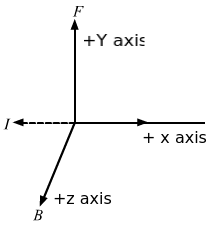
As the particle gets deflected towards the positive y-axis, we can conclude that force is acting on the particle along the positive y-axis. Now, as the electron is moving along the positive x-axis, the current can be assumed to be flowing along the negative x-axis. Applying Fleming’s left-hand rule, we find that the thumb points in the direction of force, i.e. the positive y-axis and the middle finger points in the direction of current, i.e. negative x-axis. Consequently, the forefinger gives us the direction of magnetic field, i.e. out of the plane of the paper or in the positive z-direction. So, we can conclude that the magnetic field is pointing along the positive z-axis.
Question 7:
Is it possible for a current loop to stay without rotating in a uniform magnetic field? If yes, what should be the orientation of the loop?
Answer:
Yes, if the direction of the area vector coincides with the direction of the magnetic field, the torque acting on the loop due to the magnetic field will become zero. Hence, no rotation will be produced in the coil.
It follows from the fact that torque acting on the loop is directly proportional to sin
θ, where
θis the angle made by the area vector with the direction of the magnetic field. So, we can see from this correlation that torque is zero if
θ = 0 or
θ= 1800.
τ = m⇀×B⇀=mBsin (θ)⇒For θ= 0 or integral multiple of π,τ =0Which implies that the coil will not rotate.
Question 8:
The net charge in a current-carrying wire is zero. Then, why does a magnetic field exert a force on it?
Answer:
The net charge in a current- carrying wire is zero. Yet, negative charge, i.e. electrons are moving in the wire towards the positive terminal. It is this motion of electrons in the conductor which produces the current in the wire and is also responsible for the magnetic force acting on the wire.
F = qVBsin(
θ), where F is the force, q is the charge of electrons, V is the velocity of electrons and B is the magnetic field.
Moreover, the positive charges on the wire are due to nucleus containing proton. As they are not moving so there is no force on them, so the force is only due to the moving electrons in the wire.
Question 9:
The torque on a current loop is zero if the angle between the positive normal and the magnetic field is either θ = 0 or θ = 180°. In which of the two orientations, the equilibrium is stable?
Answer:
If the angle between the positive normal and the magnetic field is 0, then the equilibrium is stable. It follows directly from the fact that U = – mBcos
θ, where m is the magnetic moment. So, when
θis 0, Potential energy, i.e. U of the system is negative, the system is more stable. But if
θis
180°, U is positive or the system is unstable.
Stability of a system depends on its energy and every system tries to minimise its energy. The configuration of the system with least energy is most stable and the configuration with the most energy is least stable or unstable.
Question 10:
Verify that the units weber and volt second are the same.
Answer:
Force experienced by the charge q moving with velocity v in a magnetic field B is given by
F = qVB
Hence, B =
FqVAlso, weber/m​2 is the unit for magnetic field B.
Now, equating both the units of the magnetic field B, we get:
Weberm2=Fq×V⇒Weber=F×m2q×m×s-1=F×mq×s-1=Wq×s=Volt×sThus, the units weber and volt second are same.
Question 1:
A positively-charged particle projected towards east is deflected towards north by a magnetic field. The field may be
(a) towards west
(b) towards south
(c) upwards
(d) downwards
Answer:
(d) downwards
A positively-charged particle projected towards east can be considered as current in the eastern direction. Here, the positive charge is deflected towards the north by a magnetic field, i.e. the positively-charged particle experiences a force in the northern direction.
Hence, in order to determine the direction of the magnetic field, we apply Fleming’s left-hand rule. According to this rule, when we stretch the thumb, the fore-finger and the middle finger mutually perpendicular to each other, then the thumb gives the direction of the force experienced by the charged particle, the fore-finger gives the direction of the magnetic field and the middle finger gives the direction of the current. Thus, if we direct the middle finger in the eastern direction, the thumb in the northern direction, we see that the fore-finger points in the downward direction.
Thus, the direction of the magnetic field is found to be in the downward direction.
Question 2:
A charged particle is whirled in a horizontal circle on a frictionless table by attaching it to a string fixed at one point. If a magnetic field is switched on in the vertical direction, the tension in the string
(a) will increase
(b) will decrease
(c) will remain the same
(d) may increase or decrease
Answer:

When the charged particle is whirled in a horizontal circle, at any moment, the current direction can be taken along the tangent of the circle. Also, the magnetic field is in the vertical direction. So, using Fleming’s left-hand rule, the force can be radially outward or inward, depending on the direction of the magnetic field, i.e. either upward or downward. Also, the direction of force depends on the direction of the whirl, i.e. clockwise or anticlockwise and obviously on the charge of the particle, i.e. whether it is positive or negative. So, the correct answer is that the tension may increase or decrease.
Question 3:
Which of the following particles will experience maximum magnetic force (magnitude) when projected with the same velocity perpendicular to a magnetic field?
(a) Electron
(b) Proton
(c) He+
(d) Li++
Answer:
(d) Li++
Force on a moving charged particle,
F = qVBsin
θ​As velocity V and magnetic field B are constant, and angle between the magnetic field and charged particle is
90°, the only thing on which force F depends is charge q.
Now, the charge on
Li++ > charge on electron, proton or
He+. So the force is maximum for
Li++.
Question 4:
Which of the following particles will describe the smallest circle when projected with the same velocity perpendicular to a magnetic field?
(a) Electron
(b) Proton
(c) He+
(d) Li+
Answer:
(a) Electron
When a particle moves in a magnetic field, the necessary centripetal force, for the particle to move in a circle, is provided by the magnetic force acting on the particle.
So, equating the Lorentz force with the cetripetal force for a charged particle of charge q describing a circle of radius r, we get:
qvB = mv2r ⇒ r = mvqBHere, m is the mass of the particle and v is its velocity.
The amount of charge of all the given particles is same; hence, for a given charge,
r∝m. And since the electron is the lightest of all the particles, it describes the smallest circle when projected with the same velocity perpendicular to the magnetic field.
Question 5:
Which of the following particles will have minimum frequency of revolution when projected with the same velocity perpendicular to a magnetic field?
(a) Electron
(b) Proton
(c) He+
(d) Li+
Answer:
(d) Li+
Time period of the revolution of the particle,
T = 2πmqBAs frequency is the reciprocal of time period, so
f = qB2πmThe charge on all the four particles is same. But the mass is maximum for Li+. So, it will have the smallest frequency of revolution.
Question 6:
A circular loop of area 1 cm2, carrying a current of 10 A, is placed in a magnetic field of 0.1 T perpendicular to the plane of the loop. The torque on the loop due to the magnetic field is
(a) zero
(b) 10−4 N m
(c) 10−2 N m
(d) 1 N m
Answer:
(a) zero
When a circular loop is placed in a uniform magnetic field, it always experiences zero toque. We all know that a current-carrying wire experiences a force when placed in an external magnetic field. But in the case of a circular loop, forces are present in pairs, i.e. they are equal and opposite in magnitude. So, for every point on the loop, there exists another point on the diametrically opposite edge for which the force is equal and opposite to the force acting on first point. So, these two forces cancel in pair. In this way, the net torque on the loop is always zero when placed in a uniform magnetic field.
Question 7:
A beam consisting of protons and electrons moving at the same speed goes through a thin region in which there is a magnetic field perpendicular to the beam. The protons and the electrons
(a) will go undeviated
(b) will be deviated by the same angle and will not separate
(c) will be deviated by different angles and hence will separate
(d) will be deviated by the same angle but will separate
Answer:
(c) will be deviated by different angles and hence will separate
Force on a charged particle, F = qVB
For an electron, this force is F =
-eVB, whereas on a proton this force is F = eVB.
Here, ‘e‘ is the charge of the electron. So, from the above formulas, we can see that electrons and protons will experience equal force but in opposite directions; so they separate out. In other words, we can say that they are deviated by different angles and causes them to separate.
Question 8:
A charged particle moves in a uniform magnetic field. The velocity of the particle at some instant makes an acute angle with the magnetic field. The path of the particle will be
(a) a straight line
(b) a circle
(c) a helix with uniform pitch
(d) a helix with non-uniform pitch
Answer:
d) helix with uniform pitch
From the figure, the velocity of the particle can be resolved in two components,Vcos
θparallel to the magnetic field and Vsin
θperpendicular to the magnetic field. We know that magnetic field does not change the speed of a particle; rather, it changes the direction of its velocity. So, a magnetic force acts on the particle due to the vertical component of velocity, which tries to move the particle in a circle.This force tries to rotate the particle in a circle. But as there is a horizontal component of velocity also, the particle will move helically with a constant pitch because no force acts on the particle along the direction of the horizontal component of velocity.
Question 9:
A particle moves in a region with a uniform magnetic field and a parallel, uniform electric field. At some instant, the velocity of the particle is perpendicular to the field direction. The path of the particle will be
(a) a straight line
(b) a circle
(c) a helix with uniform pitch
(d) a helix with non-uniform pitch
Answer:
(d) a helix with non-uniform pitch
Here, the total Lorentz force on the particle,
F = qE + qVB
We all know that magnetic field B does not change the speed of the particle but changes its direction. But as an electric field is also present that accelerate the particle in the direction of the field, the resultant path is a helix with a non-uniform pitch.
Question 10:
An electric current i enters and leaves a uniform circular wire of radius a through diametrically opposite points. A charged particle q, moving along the axis of the circular wire, passes through its centre at speed v. The magnetic force acting on the particle, when it passes through the centre, has a magnitude equal to
(a)
qvμ0 i2a(b)
qvμ0 i2πa(c)
qvμ0 ia(d) zero
Answer:
(d) zero
We can use the right-hand thumb rule to get the direction of magnetic field due to the current-carrying wire. Based on this, it can be determined that the direction of magnetic field is along the axis of the wire. Also, the charged particle is moving along the axis. So, no magnetic force will act on it, as the angle between the magnetic field and the velocity of the charged particle may be
0°or
180°. So, sin
θof the angles between velocity and magnetic field is zero.
Also, the force, F=qVB sin
θ.
So, the force on the charged particle is zero.
Question 1:
If a charged particle at rest experiences no electromagnetic force,
(a) the electric field must be zero
(b) the magnetic field must be zero
(c) the electric field may or may not be zero
(d) the magnetic field may or may not be zero
Answer:
(a) the electric field must be zero
(d) the magnetic field may or may not be zero
As the charged particle is at rest, its velocity, V = 0 and magnetic force, F = qVB = 0. Hence, we cannot determine whether a magnetic field is present or not.
But as the particle at rest experiences no electromagnetic force, the electric field must be zero. This is because electric force acts on a particle whether it is at rest or in motion.
Page No 230:
Question 2:
If a charged particle kept at rest experiences an electromagnetic force,
(a) the electric field must not be zero
(b) the magnetic field must not be zero
(c) the electric field may or may not be zero
(d) the magnetic field may or may not be zero
Answer:
(a) the electric field must not be zero
(d) the magnetic field may or may not be zero
As the charged particle is at rest, its velocity, V = 0 and magnetic force, F = qVB = 0. Hence, we cannot determine whether a magnetic field is present or not. But as the particle at rest experiences an electromagnetic force, the electric field must be non-zero. As electric force acts on a particle, whether it is at rest or in motion, an electric force must be present.
Question 3:
If a charged particle projected in a gravity-free room deflects,
(a) there must be an electric field
(b) there must be a magnetic field
(c) both fields cannot be zero
(d) both fields can be non-zero
Answer:
(c) both fields cannot be zero
(d) both fields can be nonzero
As the particle gets deflected, a force acts on the particle. So, either it has got deflected due to the magnetic force or electric force; so, both the fields cannot be zero. Also, the particle can be deflected under the combined effect of magnetic and electric forces; so, both fields can be non-zero.
Question 4:
A charged particle moves in a gravity-free space without change in velocity. Which of the following is/are possible?
(a) E = 0, B = 0
(b) E = 0, B ≠ 0
(c) E ≠ 0, B = 0
(d) E ≠ 0, B ≠ 0
Answer:
(a) E = 0, B = 0
(b) E = 0, B ≠ 0
(d) E ≠ 0, B ≠ 0
A charged particle can move in a gravity-free space without any change in velocity in the following three ways:
(1) E = 0, B = 0, i.e. no force is acting on the particle and hence, it moves with a constant velocity.
(2) E = 0, B ≠​ 0. If magnetic field is along the direction of the velocity v, then the force acting on the charged particle will be zero, as F = q v
× B = 0. Hence, the particle will not accelerate.
(3) If the force due to magnetic field and the force due to electric field counterbalance each other, then the net force acting on the particle will be zero and hence, the particle will move with a constant velocity.
Question 5:
A charged particle moves along a circle under the action of possible constant electric and magnetic fields. Which of the following is possible?
(a) E = 0, B = 0
(b) E = 0, B ≠ 0
(c) E ≠ 0, B = 0
(d) E ≠ 0, B ≠ 0
Answer:
(b) E = 0, B ≠ 0
The electric field exerts a force q E on the charged particle, which always accelerates (increases the speed) the particle. The particle can never be rotated in a circle by the electric field because then the radius of the orbit will keep on increasing due to the acceleration, which is not possible. So, options (c) and (d) are incorrect. On the other hand, a magnetic field does not change the magnitude of the velocity but changes only the direction of the velocity. Since the particle is moving in a circle, where its speed remains constant and only the direction of velocity changes, so it can only be achieved if E = 0 and B ≠ 0.
Question 6:
A charged particle goes undeflected in a region containing an electric and a magnetic field. It is possible that
(a)
E→∥B→, v →∥E →(b)
E→is not parallel to
B→(c)
v →∥B →but
E →is not parallel to
B →(d)
E →∥B →but
v →is not parallel to
E →
Answer:
(a)
E→ || B→,
v →|| E→(b)
E→is not parallel to
B→In option (a) velocity, electric field and magnetic field are parallel to each other. So, the particle may accelerate but always continue to travel in the same straight path or go undeflected.
Another possibility of the particle to go undeviated is that magnetic force acting on it is counterbalanced by electric force. This is possible if all the three, i.e. velocity, magnetic field and electric field are perpendicular to each other, so that magnetic force is balanced by electric force. So option (b) can also be one possibility. But (c) and (d) are wrong statements.
Question 7:
If a charged particle moves unaccelerated in a region containing electric and magnetic fields,
(a)
E →must be perpendicular to
B →(b)
v →must be perpendicular to
E →(c)
v →must be perpendicular to
B →(d) E must be equal to vB
Answer:
(a)
→E must be perpendicular to
→B(b)
→v must be perpendicular to
→EAs the charged particle is not accelerated, the field
→Ecannot be parallel to velocity
→v. Hence, the velocity
→vis perpendicular to the electric field
→E.
The magnetic force, i.e. force due to the magnetic field, acts in a direction perpendicular to the plane containing
→vand
→B. Hence, in order to counterbalance the magnetic force, an equal and opposite electric force must be applied along the same axis in which the magnetic force is acting. Hence
→Emust be perpendicular to
→vand
→B.
E −→
Question 8:
Two ions have equal masses but one is singly-ionised and the other is doubly-ionised. They are projected from the same place in a uniform magnetic field with the same velocity perpendicular to the field.
(a) Both ions will move along circles of equal radii.
(b) The circle described by the singly-ionised charge will have a radius that is double that of the other circle.
(c) The two circles do not touch each other.
(d) The two circles touch each other.
Answer:
(b) The circle described by the singly-ionised charge will have a radius that is double that of the other circle.
(d) The two circles touch each other.
The radius of the orbit of a charged particle in an external magnetic field,
r=mVqB,
where r is the radius of the circle, m is the mass of the ion, V is the velocity with which the ion is projected, q is the charge on the ion and B is the uniform magnetic field.
Since the mass m, the velocity V and the magnetic field B are same for both the ions, r is inversely proportional to the charge on the ion.
Hence, the radius of the circle described by the singly-charged ion will be twice the radius of the circle described by doubly-ionised ion.
Moreover, as both the charges are projected from the same place, the two circles described by them will touch each other at the point of projection.

Question 9:
An electron is moving along the positive x-axis. You want to apply a magnetic field for a short time so that the electron may reverse its direction and move parallel to the negative x-axis. This can be done by applying the magnetic field along
(a) y-axis
(b) z-axis
(c) y-axis only
(d) z-axis only
Answer:
(a) y-axis
(b) z-axis
Any magnetic field, except one parallel to the direction of velocity can change the direction of the particle. Therefore, either the magnetic field along y-axis or along z-axis can reverse the direction of the particle, as the velocity is along the x direction
Question 10:
Let
E →and
B →denote electric and magnetic fields in a frame S and
E’ →and
B’ →in another frame S‘ moving with respect to S at a velocity
v →. Two of the following equations are wrong. Identify them.
(a)
By’=By+vEzc2(b)
Ey’=Ey-vBzc2(c) By‘ = By + vEz
(d) Ey‘ = Ey + vBz
Answer:
(b) Ey‘ = Ey –
vBzc2
(c)
By’ = By+vEzElectric force due to a charged particle is q E and magnetic force is q V B.
We can sort out the two wrong equations using dimensional analysis. Now, equating the above two forces. we get:
E = V B
Hence, analysing the answers using dimensional analysis, we see that the second term on the RHS of the equations (b) and (c) are not dimensionally correct. Thus, the options (b) and (c) are wrong.
Question 1:
An alpha particle is projected vertically upward with a speed of 3.0 × 104 km s−1 in a region where a magnetic field of magnitude 1.0 T exists in the direction south to north. Find the magnetic force that acts on the α-particle.
Answer:
Given:
Upward speed of the alpha particle, v = 3 × 104 km/s = 3 × 107 m/s
Magnetic field, B = 1.0 T
The direction of the magnetic field is from south to north.
Charge of the alpha particle, q = 2e,
where e is the charge of an electron.
q = 2 × 1.6 × 10−19 C,
Magnetic force acting on the α-particle,
F →= qv→×B→sin90°= 2 × 1.6 × 10−19 × 3 × 107 × 1
= 9.6 × 10−12 N, towards west
The direction of magnetic force can be found using Fleming’s left-hand rule.
Question 2:
An electron is projected horizontally with a kinetic energy of 10 keV. A magnetic field of strength 1.0 × 10−7 T exists in the vertically upward direction. (a) Will the electron deflect towards the right or left of its motion? (b) Calculate the sideways deflection of the electron while travelling through 1 m. Make appropriate approximations.
Answer:
Given:
The kinetic energy of the electron projected in the horizontal direction, K.E = 10 keV = 1.6 × 10−15 J
Magnetic field, B = 1 × 10−7 T
The direction of magnetic field is vertically upward.
(a) The direction can be found by the right-hand screw rule. So, the electron will be deflected towards left.
(b) Kinetic energy,
K.E.=12mv2v=K.E.×2mMagnetic force,
F→=qv→×B→ ….(i)
and F = ma
Therefore, equation (i) will be
a=qv→×B→mApplying equation of motion
s = ut +
12at2,
t= Time taken to cross the magnetic field
As there is no force acting on the electron in the horizontal direction, the velocity of the electron remain constant in this direction.
So, the time taken to cross a distance of 1m in the horizontal direction in the magnetic field,
t=dvhorizontal=12×K.EmPutting the respective value of the variables, we get:
y = 12qvBmt2=12qvBm12×K.Em=qvB4×K.E=14 1.6×10-19×1×10-7×2×K.Em10×10-16= 0.148×10-3 m=0.01482 cms = 0.0148 = 1.5 × 10−2 cm
Question 3:
A magnetic field of (4.0 × 10−3
k→) T exerts a force of (4.0
i→+ 3.0
j→) × 10−10 N on a particle with a charge of 1.0 × 10−9 C and going in the x−y plane. Find the velocity of the particle.
Answer:
Given:
Magnetic field, B = (4 × 10−3
k^)T
Force exerted by the magnetic field on the charged particle, F = (4
i^+ 3
j^) × 10−10 N
Charge of the particle, q = 1 × 10−9 C
As per the question, the charge is going in the X-Y plane.
So, the x-component of force, Fx = 4 × 10−10 N
and the y-component of force, Fy = 3 × 10−10 N
Considering the motion along x-axis:
Fx = qvy×B
On putting the respective values, we get:
vy = 100 m/s
Motion along y-axis:
Fy = qvx×B
⇒ vx = 75 m/s
Thus, total velocity = (−75
i→+ 100
j→) m/s
Question 4:
An experimenter’s diary reads as follows: “A charged particle is projected in a magnetic field of (7.0
i→− 3.0
j→) × 10−3 T. The acceleration of the particle is found to be (
□i→+ 7.0
j→) × 10−6 m s−2.” The number to the left of
i→in the last expression was not readable. What can this number be?
Answer:
Given,
Magnetic field, B = (7.0i − 3.0j) × 10−3 T
Acceleration of the particle, a = (xi + 7j) × 10−6 m/s2
We have denoted the unidentified number as x.
B and a are perpendicular to each other. (Because magnetic force always acts perpendicular to the motion of the particle)
So, the dot product of the two quantities should be zero.
That is, B.a = 0
⇒ 7x × 10−3 × 10−6 − 3 × 10−3 × 7 × 10−6 = 0
⇒ 7x − 21 = 0
x=217=3Acceleration of the particle is (3i + 7j) × 10−6 m/s2.
Question 5:
A 10 g bullet with a charge of 4.00 μC is fired at a speed of 270 m s−1 in a horizontal direction. A vertical magnetic field of 500 µT exists in the space. Find the deflection of the bullet due to the magnetic field as it travels through 100 m. Make appropriate approximations.
Answer:
Given:
Mass of the bullet, m = 10g
Charge of the bullet, q = 4.00 μC
Speed of the bullet in horizontal direction, v = 270 m/s
Vertical magnetic field, B = 500 μT
Distance travelled by the bullet, d = 100 m
Magnetic force,
F→ = qv→×B→ ….(i)
Also,
F = ma
Using equation (i) we can write:
ma = qv→×B→
a = qvBmTime taken by the bullet to travel 100 m horizontally,
t = dv = 100270 sDeflection due to the magnetic field in this time interval,
y = 12at2= 12×4.00×10-6×270×500×10-610×10-3×1002702= 3.7×10-6 m.
Question 6:
When a proton is released from rest in a room, it starts with an initial acceleration a0 towards west. When it is projected towards north with a speed v0, it moves with an initial acceleration 3a0 towards west. Find the electric field and the maximum possible magnetic field in the room.
Answer:
Given:
The initial acceleration of a proton, when it is released from rest, is a0 towards west.
F = qE ….(i)
F = ma0 ….(ii)
Here, q is the charge, E is the electric field and m is the mass.
On equating both the forces F of equations (i) and (ii), we get:
qE = ma0
⇒E=ma0qtowards west.
When the proton is projected towards north with a speed v0, it moves with an initial acceleration 3a0 towards west.
F→=qv→0×B→,
where B is the magnetic field.
⇒B=F→qv0Again, an electric force will act on the proton in the west direction, due to which, an acceleration a0 will act on the proton.Now, as the proton was initially moving with a velocity v, a magnetic force is also acting on the proton.So, the change in acceleration of the proton will be solely due to the magnetic force acting on it.
Change in acceleration towards west due to the magnetic force
= 3a0 − a0 = 2a0
So, F = m2a0
Hence, required magnetic field,
B=2ma0qv0
Question 7:
Consider a 10-cm long portion of a straight wire carrying a current of 10 A placed in a magnetic field of 0.1 T making an angle of 53° with the wire. What magnetic force does the wire experience?
Answer:
Given:
A straight wire of length, l = 10 cm
Electric current flowing through the wire, I = 10 A
Magnetic field, B = 0.1 T
Angle between the wire and magnetic field, θ = 53Ëš
Magnetic force,
F→=Il→×B→∴
F→= IlBsinθ
∴
F→= IlBsin53Ëš
⇒F = 10 × 10 × 10−2 × 0.1 × 0.798
⇒ F→= 0.0798
≈0.08 N
The direction of force can be found using Fleming’s left-hand rule.
Therefore, the direction of magnetic force is perpendicular to the wire as well as the magnetic field.
Question 8:
A current of 2 A enters at the corner d of a square frame abcd of side 20 cm and leaves at the opposite corner b. A magnetic field B = 0.1 T exists in the space in a direction perpendicular to the plane of the frame, as shown in the figure. Find the magnitude and direction of the magnetic forces on the four sides of the frame.
Figure
Answer:
Given:
A square frame abcd of side, l = 20 cm
Electric current through the wire, I = 2 A
Magnetic field, B = 0.1 T
The direction of magnetic field is perpendicular to the plane of the frame, coming out of the plane.
As per the question, current enters at the corner d of the square frame and leaves at the opposite corner b.
Angle between the frame and magnetic field, θ = 90Ëš
Magnetic force,
F→=il→×B→For wire da and cb,
F→= ilBsinθ
∴
F→= ilBsin90Ëš
=
22× 20 × 10−2 × 0.1
= 0.02 N
The direction of force can be found using Fleming’s left-hand rule.
Thus, the direction of magnetic force is towards the left.
For wires dc and ab,
F→= ilBsinθ
∴
F→= ilBsin90Ëš
=
22× 20 × 10−2 × 0.1
= 0.02 N
The direction of force can be found using Fleming’s left-hand rule.
Thus, the direction of magnetic force is downwards.
Page No 231:
Question 9:
A magnetic field of strength 1.0 T is produced by a strong electromagnet in a cylindrical region of radius 4.0 cm, as shown in the figure. A wire, carrying a current of 2.0 A, is placed perpendicular to and intersecting the axis of the cylindrical region. Find the magnitude of the force acting on the wire.
Figure
Answer:
Given:
Magnetic field, (B) = 1 T
Radius of the cylindrical region, r = 4.0 cm
Electric current through the wire, I = 2 A
The direction of magnetic field is perpendicular to the plane of the wire.
So, angle between wire and magnetic field, θ = 90Ëš
Magnetic force,
F→ = il→×B→∴
F→= ilBsinθ
F→= ilBsin90Ëš
Here, l = 2r
∴
F→= i2rBsin90Ëš
= 2 × 8 × 10−2 × 1.0 × 1
= 0.16N
Question 10:
A wire of length l carries a current i long the x-axis. A magnetic field exists, which is given as
B→=B0(i→+j→+k→)T. Find the magnitude of the magnetic force acting on the wire.
Answer:
Given:
A wire of length l cm
Electric current through the wire = i
Magnetic field,
B→=B0(i→+j→+k→)T.
As per the question, the current is passing along the X-axis.
Magnetic force,
F→=il→×B→Putting the repective values in the above equation, we get:
= i{(l
i→) × (B0
i→+ B0
j→+ B0
k→)}
= i{lB0
k→− lB0
j→}
= ilB0{−
j→+
k→}
The magnitude of the magnetic force,
F→=
2i2l2B02∴
F→=
2ilB0
Question 11:
A current of 5.0 A exists in the circuit shown in the figure. The wire PQ has a length of 50 cm and the magnetic field in which it is immersed has a magnitude of 0.20 T. Find the magnetic force acting on the wire PQ.
Figure
Answer:
Given:
Length of the wire PQ inside the magnetic field, l = 50 cm
Electric current through the wire, I = 5 A
Magnetic field, B = 0.2 T
The direction of magnetic field is perpendicular to the plane of the frame and it is going into the plane of the circuit.
As per the question,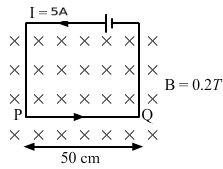
Angle between the plane of the wire and the magnetic field, θ = 90Ëš
Magnetic force,
F→=il→×B→∴
F→= ilBsinθ
∴
F→= ilBsin90Ëš
= 5 × 50 × 10−2 × 0.2 × 1
= 0.50 N
The direction of force can be found using Fleming’s left-hand rule.
Thus, the direction of magnetic force is upwards in the plane of the paper.
Question 12:
A circular loop of radius a, carrying a current i, is placed in a two-dimensional magnetic field. The centre of the loop coincides with the centre of the field (figure). The strength of the magnetic field at the periphery of the loop is B. Find the magnetic force on the wire.
Figure
Answer:
Given:
A circular loop of radius = a
So, the length of the loop, l = 2πa
Electric current through the loop = i
As per the question,
The loop is placed in a two-dimensional magnetic field. The centre of the loop coincides with the centre of the field. The strength of the magnetic field at the periphery of the loop is B
Therefore, the magnetic field points radially outwards.
Here, the angle between the length of the loop and the magnetic field, θ = 90Ëš
Magnetic force is given by
F→ = il→×B→F →= i2πa×B→F→ = i2πaBsin90°= i2πaB
Direction of the force can be found using Fleming’s left-hand rule.
Thus, the direction of magnetic force is perpendicular to the plane of the figure and pointing inside.
Question 13:
A hypothetical magnetic field existing in a region is given by
B→=B0e→r,where
e→rdenotes the unit vector along the radial direction. A circular loop of radius a, carrying a current i, is placed with its plane parallel to the x−y plane and the centre at (0, 0, d). Find the magnitude of the magnetic force acting on the loop.
Answer:
Given:
A hypothetical magnetic field existing in a region,
B→=B0e→rwhere
e→rdenotes the unit vector along the radial direction.
A circular loop of radius a
So, the length of the loop, l = 2πa
Electric current through loop = i
As per the question, the loop is placed with its plane parallel to the X−Y plane and its centre is at (0, 0, d).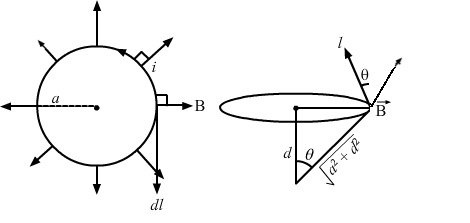
Here, angle between the length of the loop and the magnetic field is θ.
Magnetic force is given by
F →= il→×B→F →= i2πa×B→F→ = i2πaBsinθ=i2πaB0aa2+d2=i2πB0a2a2+d2
Question 14:
A rectangular wire-loop of width a is suspended from the insulated pan of a spring balance, as shown in the figure. A current i exists in the anti-clockwise direction in the loop. A magnetic field B exists in the lower region. Find the change in the tension of the spring if the current in the loop is reversed.
Figure
Answer:
Given,
A rectangular wire loop of width a
Electric current through the loop = i
Direction of the current is anti-clockwise.
Strength of the magnetic field in the lower region = B
Direction of the magnetic field is into the plane of the loop.

Here, angle between the length of the loop and magnetic field, θ = 90Ëš
Magnetic force is given by
F →= ia→×B→The magnetic force will act only on side AD and BC.
As side AD is outside the magnetic field, so F = 0
Magnetic force on side BC is
F→ = ia→×B→ = iaBsinθ = iaBDirection of force can be found using Fleming’s left-hand rule.
Thus, the direction of the magnetic force is upward.
Similarly if we change the direction of current to clockwise,
the force along BC,
F→=ia→×B→=-iaBThus, the change in force is equal to the change in tension
= iaB − (− iaB) = 2iaB.
Question 15:
A current loop of arbitrary shape lies in a uniform magnetic field B. Show that the net magnetic force acting on the loop is zero.
Answer:
Given:
Uniform magnetic field existing in the region of the arbitrary loop = B
Let the electric current flowing through the loop be i.
Length of each side of the loop is l.
Assume that the direction of the current is clockwise.
Direction of the magnetic field is going into the plane of the loop.
Magnetic force is given by
F→ = il→×B→F→ = ilBsinθ
Here, θ = 90Ëš
Direction of force can be found using Fleming’s lef- hand rule.
Force F1 acting on AB = ilB upwards
Force F2 acting on DC = ilB downwards
So, F1 and F2 cancel each other.
Force F3 acting on AD = ilB outwards (Pointing towards the left from AB)
Force F4 acting on BC = ilB outwards (Pointing towards the right from BC)
So, F3 and F4 cancel each other.
Therefore, the net force acting on the arbitrary loop is 0.
Question 16:
Prove that the force acting on a current-carrying wire, joining two fixed points a and b in a uniform magnetic field, is independent of the shape of the wire.
Answer:
Given:
Uniform magnetic field existing in the region of the wire = B
Let the electric current flowing through the wire be i.
Length of the wire between two points a and b = l
Magnetic force is given by
F→=il→×B→F→=ilBsinθLet us consider two wires of length l, one straight and the other circular.
The circular wire is of radius a such that
2πa = lSuppose the magnetic field is pointing along the z direction and both the wires are lying in the xy plane, so that the angle between the area vector and the magnetic field is
90°.
For the straight wire of length l lying in a uniform magnetic field of strength B:
Force, F =
ilBsin(90°)= ilB
For the circular wire:
Length, l =
2πaAngel between the area vector and magnetic field will again be
90°.
Force acting on the circular wire,
F =
i(2πa)Bsin(90°) =
i2πaB = ilBBoth the forces are equal in magnitude. This implies that the magnetic force is independent of the shape of the wire and depends on the length and orientation of the wire.
Therefore, the magnetic force is independent of the shape of the wire.
Question 17:
A semicircular wire of radius 5.0 cm carries a current of 5.0 A. A magnetic field B of magnitude 0.50 T exists along the perpendicular to the plane of the wire. Find the magnitude of the magnetic force acting on the wire.
Answer:
Given,
Radius of semicircular wire, r = 5.0 cm
Thus, the length of the wire = 2r
Electric current flowing through wire = 5.0 A
Magnetic field, B = 0.50 T
Direction of magnetic field is perpendicular to the plane of the wire which implies that angle between length of the wire and magnetic field, θ = 90Ëš
As we know the magnetic force is given by
F→ = Il→×B→F→ = I2rBsin90°=5× 2 × 0.05 × 0.5 = 0.25 N
Question 18:
A wire, carrying a current i, is kept in the x−y plane along the curve
y=A sin2πλx.A magnetic field B exists in the z direction. Find the magnitude of the magnetic force on the portion of the wire between x = 0 and x = λ.
Answer:
Given:
Electric current flowing through the wire = i
The wire is kept in the x−y plane along the curve,
y=A sin2πλxMagnetic field (B) exists in the z direction.
We have to find the magnetic force on the portion of the wire between x = 0 and x = λ.
Magnetic force is given by
F→=il→×B→For a small element dl,
dF→=idl×B→The effective force on the whole wire is equivalent to the force on a starlight wire of length λ placed along the x axis.
So,
F=iB∫0λdl
⇒F=iλB
Question 19:
A rigid wire consists of a semi-circular portion of radius R and two straight sections (figure). The wire is partially immersed in a perpendicular magnetic field B, as shown in the figure. Find the magnetic force on the wire if it carries a current i.
Figure
Answer:
Given:
Radius of the semi-circular portion of the rigid wire = R
Magnetic field = B
Electric current flowing through the wire = i
As per the question, the wire is partially immersed in a perpendicular magnetic field.
As PQ and RS are straight wires of length l each and strength of the magnetic field is also same on both the wires, the force acting on these wires will be equal in magnitude but their directions will be opposite to each other.(Direction of force can be found out using Fleming’s left hand rule.)
So, the magnetic force on the wire PQ and the force on the wire RS are equal and opposite to each other. Both the forces cancel each other.
Therefore, only the semicircular loop PR will experience a net magnetic force.
Here, angle between the length of the wire and magnetic field, θ = 90Ëš
Magnetic force in the loop PR,
F →= il→×B→Here, l = 2R
F→ = i2R×B→F→ = i2RBsin90° = i2RB
Question 20:
A straight horizontal wire of mass 10 mg and length 1.0 m carries a current of 2.0 A. What minimum magnetic field B should be applied in the region, so that the magnetic force on the wire may balance its weight?
Answer:
Given:
Mass of the wire, M = 10 mg = 10−5 Kg
Length of the wire, l = 1.0 m
Electric current flowing through wire, I = 2.0 A
As per the question, the weight of the wire should be balanced by the magnetic force acting on the wire.Also angle between the length of the wire and magnetic field is
90°.
Thus, Mg = IlB, where
g is the acceleration due to gravity = 9.8 m/s2
B is the applied magnetic field
So,
B = MgIl= 10-5×9.82×1= 4.9×10-5 T
Question 21:
Figure shows a rod PQ of length 20.0 cm and mass 200 g suspended through a fixed point O by two threads of lengths 20.0 cm each. A magnetic field of strength 0.500 T exists in the vicinity of the wire PQ, as shown in the figure. The wires connecting PQ with the battery are loose and exert no force on PQ. (a) Find the tension in the threads when the switch S is open. (b) A current of 2.0 A is established when the switch S is closed. Find the tension in the threads now.
Figure
Answer:

Given:
Length of the rod PQ = 20.0 cm
Mass of the rod, M = 200 g
Length of the two threads, l = 20.0 cm
Applied magnetic field, B = 0.500 T
As per the question,
(a) When the circuit is open:
The weight of the rod is balanced by the tension in the rod. So,
2Tcos30° = Mg
T = Mg2cos30°= 0.2×9.8232= 1.13 N(b) When the circuit is closed and current flowing through the circuit = 2 A:
Then,
2Tcos 30°= Mg + ilB
= 0.200× 9.8 + 2 × 0.2 × 0.5
= 1.95 + 0.2 = 2.16
⇒ 2T =
2.16×23⇒ T = 1.245 = 1.25 N
Page No 232:
Question 22:
Two metal strips, each of length l, are clamped parallel to each other on a horizontal floor with a separation b between them. A wire of mass m lies on them perpendicularly, as shown in the figure. A vertically-upward magnetic field of strength B exists in the space. The metal strips are smooth but the coefficient of friction between the wire and the floor is µ. A current i is established when the switch S is closed at the instant t = 0. Discuss the motion of the wire after the switch is closed. How far away from the strips will the wire reach?
Figure
Answer:
Given:
Length of the two metal strips = l
Separation between the strips = b
Mass of the wire = m
Strength magnetic field = B
Coefficient of friction between the wire and the floor = µ
Let the distance covered by the wire be x.
Due to the presence of the magnetic field, a net magnetic force will act on the wire towards the right.
Let the wire has moved through a distance x after travelling the length of the strips.
As the contact between the wire and strip is smooth so coefficient of friction between them is zero. Under the influence of magnetic force,firstly the wire will travel a distance equal to the length of the strips. After this, it travels a distance x and also now,a frictional force will act on the wire in a direction opposite to its direction of motion.
So we can equate the work done by the magnetic force and the frictional force.
Thus, F × l = µmg × x,
where g is the acceleration due to gravity
⇒ ibBl = µmgx
⇒x = iblBμmg
Question 23:
A metal wire PQ of mass 10 g lies at rest on two horizontal metal rails separated by 4.90 cm (figure). A vertically-downward magnetic field of magnitude 0.800 T exists in the space. The resistance of the circuit is slowly decreased and it is found that when the resistance goes below 20.0 Ω, the wire PQ starts sliding on the rails. Find the coefficient of friction.
Figure
Answer:
Given:
Mass of the metal wire, M = 10 g
Distance between the two horizontal metal rails, l = 4.90 cm
Vertically-downward magnetic field, B = 0.800 T
As per the question, when the resistance of the circuit is slowly decreased below 20.0 Ω, the wire PQ starts sliding on the rails. At that moment,
current in the wire, i =
VR = 620A
Using Fleming’s left-hand rule, the magnetic force will act towards the right. So, due to this magnetic force, the wire will try to slide on the rails.The frictional force will try to oppose this motion of the wire.When the wire just starts sliding on the rails, the frictional force acting on the wire will just balance the magnetic force acting on the wire.This implies
µR = F, where
µ is the coffiecent of friction
R is the normal reaction force and
F is the magnetic force
⇒ µ × M × g = ilB
µ × 10 × 10−3 × 9.8 =
620× 4.9 × 10−2 × 0.8
μ = 6×4.9×10-2×0.820×10×10-3×9.8µ = 0.12
Question 24:
A straight wire of length l can slide on two parallel plastic rails kept in a horizontal plane with a separation d. The coefficient of friction between the wire and the rails is µ. If the wire carries a current i, what minimum magnetic field should exist in the space in order to slide the wire on the rails?
Answer:
Given:
Length of the wire = l
Distance between the plastic rails = d
The coefficient of friction between the wire and the rails = µ
Electric current flowing through the wire = i
The minimum magnetic field that should exist in the space, in order to slide the wire on the rails, should be such that the net magnetic force acting on the wire is equal to the frictional force on the wire.
µR = F,
where
µ is the coefficient of friction between the wire and the rail
R is the normal reaction force
F is the magnetic force
µMg = iBl
B = μMgil
Question 25:
The figure shows a circular wire loop of radius a and carrying a current i, which is placed in a perpendicular magnetic field B. (a) Consider a small part dl of the wire. Find the force on this part of the wire exerted by the magnetic field. (b) Find the force of compression in the wire.
Figure
Answer:
Given:
Radius of the circular wire loop = a
Electric current flowing through the loop = i
Perpendicular magnetic field = B
(a) The force exerted by the magnetic field on a small element dl of the wire,
Fdl = i. (dl × B) = idlB
Using Fleming’s left-hand rule, we can say that the direction of magnetic force is towards the centre for any small element of length dl of the wire (dl and B are perpendicular to each other).
(b) Suppose some part of wire loop subtends a small angle 2θ at the centre of a circular loop

So,
2Tsinθ = i.(dl × B)
= i.2aθ B (Using length of any arc, l =rθ)
∵ θ is very small, sinθ = θ
2Tθ = i.2aθB
∴ T = iaB
Question 26:
Suppose that the radius of cross-section of the wire used in the previous problem is r. Find the increase in the radius of the loop if the magnetic field is switched off. Young’s modulus of the material of the wire is Y.
Answer:
Given:
Radius of cross-section of the wire = r
Young’s modulus of the material of the wire is Y.
As per the question, when the applied magnetic field is switched off, the tension in the wire increased and so did its length.
Young’s modulus,
Y = StressStrainY = T/A∆l/lHere,
T is the tension
A is the area of cross-section
Δl is the increse in length of the wire
∆l = TlYA =iaB×lY×πr22π×∆r = iaB×2πaY×πr2∆r=ia2Bπr2Y
Question 27:
The magnetic field existing in a region is given by
B→=B01+xlk→. A square loop of edge l and carrying a current i, is placed with its edges parallel to the x−y axes. Find the magnitude of the net magnetic force experienced by the loop.
Answer:
Given:
Magnetic field,
B→=B01+xlk→Length of the edge of a square loop = l
Electric current flowing through it = i
As per the question, the loop is placed with its edges parallel to the X−Y axes.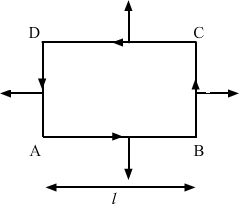
In the figure, arrow denotes the direction of force on different sides of the square.
The net magnetic force experienced by the loop,
F→=il→×B→Force on AB:
Consider a small element of length dx at a distance x from the origin on line AB.
Force on this small element,
dF = iB0(1+xl)dxForce on the full length of AB,
FAB = ∫x=0x=liB0(1+xl)dx= iB0∫x=0x=l(dx +1lxdx)= iB0(l+l2)= 3iB0l2
Force on AB will be acting downwards.
Similarly, force on CD,
F2=iB0l+l2 =3iB0l2So, the net vertical force = F1 − F2 = 0
Force on AD,
F3=iB0l1+0l =iB0lForce on BC
F4=iB0l1+1l =2iB0lSo, the net horizontal force = F4−F3 = iB0l
Question 28:
A conducting wire of length l, lying normal to a magnetic field B, moves with a velocity v, as shown in the figure. (a) Find the average magnetic force on a free electron of the wire. (b) Due to this magnetic force, electrons concentrate at one end, resulting in an electric field inside the wire. The redistribution stops when the electric force on the free electrons balances the magnetic force. Find the electric field developed inside the wire when the redistribution stops. (c) What potential difference is developed between the ends of the wire?
Figure
Answer:
Given:
Length of the conducting wire = l
Inward magnetic field = B
Velocity of the conducting wire = v
As the wire is moving with velocity v, we can consider this as the net motion of electrons inside the wire with velocity v.
(a) The average magnetic force on a free electron of the wire
= e(v × B) = evB, where e is the charge of an electron.
(b) The redistribution stops when the electric force is just balanced by the magnetic force.
Electric force, F = eE and also magnetic force, F = evB
On equatinging the two forces, we get:
eE = evB
⇒E = vB
(c) The potential difference is developed between the ends of the wire:
V = lE = lvB, where V is the potential difference across the ends of the wire.
Question 29:
A current i is passed through a silver strip of width d and area of cross-section A. The number of free electrons per unit volume is n. (a) Find the drift velocity v of the electrons. (b) If a magnetic field B exists in the region, as shown in the figure, what is the average magnetic force on the free electrons? (c) Due to the magnetic force, the free electrons get accumulated on one side of the conductor along its length. This produces a transverse electric field in the conductor, which opposes the magnetic force on the electrons. Find the magnitude of the electric field which will stop further accumulation of electrons. (d) What will be the potential difference developed across the width of the conductor due to the electron-accumulation? The appearance of a transverse emf, when a current-carrying wire is placed in a magnetic field, is called Hall effect.
Figure
Answer:
Given:
Width of the silver strip = d
Area of cross-section = A
Electric current flowing through the strip = i
The number of free electrons per unit volume = n
(a) The relation between the drift velocity and current through any wire,
i = vnAe, where e = charge of an electron and v is the drift velocity.
v = inAe(b)The magnetic field existing in the region is B.
The average magnetic force on a current-carrying conductor,
F = ilB
So, the force on a free electron
=
ilBnAl = iBnAupwards (Using Fleming’s left-hand rule)
(c) Let us take the electric field as E.
So, further accumulation of electrons will stop when the electric force is just balanced by the magnetic force.
eE = F = iBAn⇒E = iBeAn(d) The potential difference developed across the width of the conductor due to the electron-accumulation will be
V = Er
⇒E×d = iBdeAn
Question 30:
A particle of charge 2.0 × 10−8 C and mass 2.0 × 10−10 g is projected with a speed of 2.0 × 103 m s−1 in a region with a uniform magnetic field of 0.10 T. The velocity is perpendicular to the field. Find the radius of the circle formed by the particle and also the time period.
Answer:
Given:
Charge of the particle, q = 2.0 × 10−8 C
Mass of the particle, m = 2.0 × 10−10 g
Projected speed of the particle, v = 2.0 × 103 m s−1
Uniform magnetic field, B = 0.10 T.
As per the question, the velocity is perpendicular to the field.
So, for the particle to move in a circle,the centrifugal force to the particle will be provided by the magnetic force acting on it.
Using qvB =
mv2r, where r is the radius of the circle formed,
r = mvqB= 2×10-13×2×1032×10-8×0.10= 20 cmTime period,
T = 2πmqB= 2×3.14×2×10-132×10-8×0.10= 6.28×10-4 s
Question 31:
A proton describes a circle of radius 1 cm in a magnetic field of strength 0.10 T. What would be the radius of the circle described by an α-particle moving with the same speed in the same magnetic field?
Answer:
Given:
Radius of the circle, r = 1 cm
Magnetic field = 0.10 T
We know that the charge of a proton is e and that of an alpha particle is 2e. Also, the mass of a proton is m and that of an aplha particle is 4m.
Suppose, both the particles are moving with speed v.
According to the question,
rp = mveB, where rp is the radius of the circle described by the proton.0.01 = mve×0.1 …(i) rα = 4mv2eBrα = 4mv2e×0.1 …(ii)On dividing equation (ii) by (i), we get:
rα0.01=4mv×e×0.12e×0.1×mv rα=0.02 m=2 cm
Question 32:
An electron of kinetic energy 100 eV circulates in a path of radius 10 cm in a magnetic field. Find the magnetic field and the number of revolutions per second made by the electron.
Answer:
Given:
Kinetic energy of an electron = 100 eV
Radius of the circle = 10 cm
12mv2= 100 eV = 1.6 × 10−17 J (1 eV = 1.6 × 10−19 J)
Here,
m is the mass of an electron and v is the speed of an electron. Thus,
12× 9.1 × 10−31 × v2 = 1.6 × 10−17 J
⇒ v2 = 0.35 × 1014
v = 0.591 × 107 m/s
Now,
r = mveB ⇒B=mver
=9.1×10-31×0.591×1071.6×10-19×0.1B = 3.3613 × 10−4 T
Therefore, the applied magnetic field = 3.4 × 10−4 T
Number of revolutions per second of the electron,
f = 1T
T = 2πrv = 2πmeB
T = 2πmBe
f = Be2πm=3.4×10-4×1.6×10-192×3.14×9.1×10-31= 0.094 × 108
= 9.4 × 106
f = 9.4 × 106
Question 33:
Protons with kinetic energy K emerge from an accelerator as a narrow beam. The beam is bent by a perpendicular magnetic field, so that it just misses a plane target kept at a distance l in front of the accelerator. Find the magnetic field.
Answer:
Given:
Kinetic energy of proton = K
Distance of the target from the accelerator = l
Therefore, radius of the circular orbit
≤l
As per the question, the beam is bent by a perpendicular magnetic field.
We know:
r = mveB
For a proton, the above equation can be written as:
l = mpveB (As r=l)….(i)
Here,
mp is the mass of a proton
v is the velocity
e is the charge
B is the magnetic field
12mpv2 = K⇒ v = 2KmpPutting the value of v in the equation (i), we get:
l = 2 KmpeBB = 2Kmpel
Page No 233:
Question 34:
A charged particle is accelerated through a potential difference of 12 kV and acquires a speed of 1.0 × 106 m s−1. It is then injected perpendicularly into a magnetic field of strength 0.2 T. Find the radius of the circle described by it.
Answer:
Given:
Applied potential difference, V = 12 kV = 12 × 103 V
Speed of a charged particle, v =1.0 × 106 m s−1
Magnetic field strength, B = 0.2 T
As per the question, a charged particle is injected perpendicularly into the magnetic field.
We know:
qV = 12mv2⇒mq = 2Vv2=2×12×1031×1062 = 24×10-9and
r=mvqB
⇒r=24×10-9×1060.2
⇒r = 12 × 10−2 m = 12 cm
Question 35:
Doubly-ionised helium ions are projected with a speed of 10 km s−1 in a direction perpendicular to a uniform magnetic field of magnitude 1.0 T. Find (a) the force acting on an ion (b) the radius of the circle in which it circulates and (c) the time taken by an ion to complete the circle.
Answer:
Given:
Speed of the helium ions, v = 10 km s−1 = 104 m/s
Uniform magnetic field, B = 1.0 T
Charge on the helium ions = 2e
Mass of the helium ions, m =
4×1.6×10-27 Kg(a) The force acting on an ion,
F = qvBsinθ
= 2 × 1.6 × 10−19 × 104 × 1.0
= 3.2 × 10−15 N
(b) The radius of the circle in which it circulates,
r = mvqB= 4×1.6×10-27×1042×1.6×10-19×1= 2×10-2310-19= 2×10-4 m(c) The time taken by an ion to complete the circle,
T = 2πrv = 6.28×2.1×10-4104= 1.31 × 10−7 s
Question 36:
A proton is projected with a velocity of 3 × 106 m s−1 perpendicular to a uniform magnetic field of 0.6 T. Find the acceleration of the proton.
Answer:
Given:
Velocity of the proton, v = 3 × 106 m s−1
Uniform magnetic field, B = 0.6 T
As per the question, the proton is projected perpendicular to a uniform magnetic field.
We know,
F = mpa….(i)
and
F = evBsinθ….(ii)
On equating (i) and (ii), we get:
ma = evBsinθ (As θ = 90Ëš)
a = evBm= 1.6×10-19×3×106×0.61.67×10-27= 1.72 × 1014 m/s2
Question 37:
(a) An electron moves along a circle of radius 1 m in a perpendicular magnetic field of strength 0.50 T. What would be its speed? Is it reasonable? (b) If a proton moves along a circle of the same radius in the same magnetic field, what would be its speed?
Answer:
Given:
(a) Radius of the circle = 1 m
Magnetic field strength = 0.50 T
We know:
r = meveBeve = rBeme, where me is the mass of the electron and ve is the speed of the electron. =1×0.50×1.6×10-199.1×10-31≈8.8×1010 m/sSince, the speed of the electron moving along the circle is greater than the speed of light, it is not reasonable.
(b) For a proton,
r = mpvpBevp = rBemp,where mp is the mass of the proton and vp is its speed.
= 1×0.50×1.6×10-191.6×10-27= 5×107 m/s
Question 38:
A particle of mass m and positive charge q, moving with a uniform velocity v, enters a magnetic field B, as shown in the figure. (a) Find the radius of the circular arc it describes in the magnetic field. (b) Find the angle subtended by the arc at the centre. (c) How long does the particle stay inside the magnetic field? (d) Solve the three parts of the above problem if the charge q on the particle is negative.
Figure
Answer:
Given:
Mass of the particle = m
Positive charge on the particle = q
Uniform velocity of the particle = v
Magnetic field = B
(a) The radius of the circular arc described by the particle in the magnetic field:
We know,
r = mvqB(b)
The angle subtended by the arc at the centre:
Line MAB is tangent to arc ABC, so the angle described by the charged particle,
∠MAO = 90°
Now, ∠NAC = 90°
OAC = OCA = θ
[by geometry]
Then, AOC =
180°− (θ + θ) (By angle-sum property of a triangle)
= π − 2θ
(c) The time for which the particle stay inside the magnetic field:
Distance covered by the particle inside the magnetic field,
l = rθ
= r(π − 2θ)
t=lv=mqB(π-2θ) Using r=mvqB(d) If the charge q on the particle is negative, then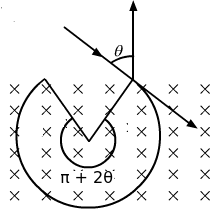
(i) Radius of circular arc,
r=mvqB(ii) The centre of the arc will lie within the magnetic field. Therefore, the angle subtended by the arc = π + 2θ
(iii) Similarly, the time taken by the particle to cover the path inside the magnetic field =
mqB(π+2θ)
Question 39:
A particle of mass m and charge q is projected into a region that has a perpendicular magnetic field B. Find the angle of deviation (figure) of the particle as it comes out of the magnetic field if the width d of the region is very slightly smaller than
(a)
mvqB(b)
mv2qB(c)
2mvqB.
Figure
Answer:
Given:
Mass of the particle = m
Charge of the particle = q
Magnetic field = B
As per the question, the particle is projected into a perpendicular magnetic field.
(a) When the width, d =
mvqB:
d is equal to the radius and θ is the angle between the radius and tangent, which is equal to
π2.
(b) When the width, d =
mv2qBWidth of the region in which a magnetic field is applied is half of the radius of the circular path described by the particle.
As the magnetic force is acting only along the y direction, the velocity of the particle will remain constant along the x direction. So, if d is the distance travelled along the x axis, then
d = vxt
t = dvx …(i)(i)  (ii)
(ii) 
The acceleration along the x direction is zero. The force will act only along the y direction.
Using the equation of motion for motion along the y axis:
vy = uy + ayt
vy = 0+quxBtm= quxBtmPutting the value of t from equation (i), we get:
quxBdmvxWe know:
tanθ = vyvxqBdmvx = qBmvx2qBmvx = 12⇒θ = tan-112= 26.4 = 30° = π6(c) When the width, d =
2mvqBFrom the figure, it can be seen that the angle between the initial direction and final direction of velocity is π.
Question 40:
A narrow beam of singly-charged carbon ions, moving at a constant velocity of 6.0 × 104 m s−1, is sent perpendicularly in a rectangular region of uniform magnetic field B = 0.5 T (figure). It is found that two beams emerge from the field in the backward direction, the separations from the incident beam being 3.0 cm and 3.5 cm. Identify the isotopes present in the ion beam. Take the mass of an ion = A(1.6 × 10−27) kg, where A is the mass number.
Figure
Answer:
Given:
Velocity of a narrow beam of singly-charged carbon ions, v = 6.0 × 104 m s−1
Strength of magnetic field B = 0.5 T
Separations between the two beams from the incident beam are 3.0 cm and 3.5 cm.
Mass of an ion = A(1.6 × 10−27) kg
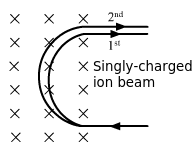
The radius of the curved path taken by the first beam,
r1=32=1.5 cm
The radius of the curved path taken by the second beam,
r2=3.52 cmWe know:
r1=m1vqB,
where m1 is the mass of the first isotope and q is the charge.
For the second beam:
r2=m2vqB,
where m2 is the mass of the first isotope and q is the charge.
r1r2 = m1m2323.52 = A1×1.6×10-27A2×1.6×10-2767 = A1A2As
r1=m1vqB
⇒m1 = qBr1v=1.6×10-19×0.5×0.0156×104=20×10-27 kg=20×10-271.6×10-27 u=12.5 uAlso,
A2 = 76A1=76×12.5=14.58 uSo, the two isotopes of carbon used are 12C6 and 14C6.
Question 41:
Fe+ ions are accelerated through a potential difference of 500 V and are injected normally into a homogeneous magnetic field B of strength 20.0 mT. Find the radius of the circular paths followed by the isotopes with mass numbers 57 and 58. Take the mass of an ion = A (1.6 × 10−27) kg, where A is the mass number.
Answer:
Given:
Potential difference through which the Fe+ ions are accelerated, V = 500 V
Strength of the homogeneous magnetic field, B = 20.0 mT = 20 × 10−3 T
Mass numbers of the two isotopes are 57 and 58.
Mass of an ion = A (1.6 × 10−27) kg
We know that the radius of the circular path described by a particle in a magnetic field,
r = mvqBFor isotope 1,r1 = m1v1qBFor isotope 2,r2 = m2v2qB⇒r1r2 =m1v1m2v2As both the isotopes are accelerated via the same potential V, the K.E gained by the two particles will be same.
qV = 12m1v12 =12m2v22m1m2 = v12 v22 ⇒r1r2 = (m1m2)32 Also, r1 = mv1qB=m12qVm1qB=1B2m1Vq
=1000×57×1.6×10-271.6×10-19×20×10-3=1.19×10-2 m =119 cmFor the second isotope:
As r1r2 = (m1m2)32,r2 = (m2m1)32 r1= (5857)32×119 cm = 120 cm
Question 42:
A narrow beam of singly charged potassium ions of kinetic energy 32 keV is injected into a region of width 1.00 cm with a magnetic field of strength 0.500 T, as shown in the figure. The ions are collected at a screen 95.5 cm away from the field region. If the beam contains isotopes of atomic weights 39 and 41, find the separation between the points where these isotopes strike the screen. Take the mass of a potassium ion = A (1.6 × 10−27) kg, where A is the mass number.
Figure
Answer:
Kinetic energy of singly-charged potassium ions = 32 keV
Width of the magnetic region = 1.00 cm
Magnetic field’s strength, B = 0.500 T
Distance between the screen and the region = 95.5 cm
Atomic weights of the two isotopes are 39 and 41.
Mass of a potassium ion = A (1.6 × 10−27) kg
For a singly-charged potassium ion K-39 :
Mass of K-39 = 39 × 1.6 × 10−27 kg,
Charge, q = 1.6 × 10−19 C
As per the question, the narrow beam of singly-charged potassium ions is injected into a region of magnetic field.
As
K.E = 32 keV
12mv2=32×103×1.6×10-19
12× 39 × (1.6 × 10−27) × v2 = 32 × 103 × 1.6 × 10−19
v = 4.05 × 105
We know that throughout the motion, the horizontal velocity remains constant.
So, the time taken to cross the magnetic field,
t =
dv=0.014.05×105= 24.7 × 10−9 s
Now, the acceleration in the magnetic field region:
F = qvB = ma
a=qvBm=1.6×10-19 ×4.05×10539×1.6×10-27
= 5192 × 108 m/s2
Velocity in the vertical direction, vy = at
= 5193.53 × 108 × 24.7 × 10−9
= 12824.24 m/s
Time taken to reach the screen
=dv=0.9554.05×105= 0.000002358 s.
Distance moved vertically in this time
= vy × t
= 12824.24 × 2358 × 10−9
= 3023.95×10-5 m
Vertical distance travelled by the particle inside magnetic field can be found out by using equaton of motion
v2 = 2aS
⇒ (12824.24)2 = 2 × 5192 × 108 × S
⇒ 15.83×10−5 = S
Net display from line
= 15.83×10−5+3023.95×10-5
= 3039.787×10−5 m.
For the potassium ion K-41l :
12× 41 × 1.6 × 10−27 v2= 32 × 103 × 1.6 × 10−9
⇒ v = 3.94×105 m/s
Similarly, acceleration,
a = 4805 × 108 m/s2
t = time taken for exiting the magnetic field
= 25.4 × 10−9 sec.
vy1= at (vertical velocity)
= 4805 × 108 × 25.4 × 10−9
= 12204.7× 10−9 m/s
Time to reach the screen
= 2423× 10−9 s.
Distance moved vertically
= 12204.7 × 2423 × 10−9
= 2957.1× 10−5
Now,
Vertical distance travelled by the particle inside magnetic field can be found out by using equaton of motion
v2 = 2aS
(12204.7)2 = 2 × 4805 × 108 S
⇒ S = 15.49× 10-5 m
Net distance travelled
= 15.49× 10-5 +2957.1× 10−5
= 2972.68× 10-5 m.
Net gap between K-39 and K-41
= 3039.787×10−5− 2972.68× 10-5
= 67 mm.
Question 43:
The figure shows a convex lens of focal length 12 cm lying in a uniform magnetic field B of magnitude 1.2 T parallel to its principal axis. A particle with charge 2.0 × 10−3 C and mass 2.0 × 10−5 kg is projected perpendicular to the plane of the diagram with a speed of 4.8 m s−1. The particle moves along a circle with its centre on the principal axis at a distance of 18 cm from the lens. Show that the image of the particle moves along a circle and find the radius of that circle.
Figure
Answer:
Given:
Focal length of the convex lens = 12 cm
Uniform magnetic field, B = 1.2 T
Charge of the particle, q = 2.0 × 10−3 C
and mass, m = 2.0 × 10−5 kg
Speed of the particle, v = 4.8 m s−1
The distance of the particle from the lens = 18 cm
As per the question, the object is projected perpendicular to the plane of the paper.
Let the radius of the circle on which the object is moving be r.
We know:
r = mvqB
r = 2×10-5×4.82×10-3×1.2r = 0.04 m = 4 cmHere, object distance, u = -18 cm
Using the lens equation
1v-1u = 1f,1v-1-18 = 112Image distance, v = 36 cm.
Let the radius of the circular path of image be r‘.
So, magnification:
vu = r’rr’ = vu×r=8 cmTherefore, the radius of the circular path in which the image moves is 8 cm.
Question 44:
Electrons emitted with negligible speed from an electron gun are accelerated through a potential difference V along the x-axis. These electrons emerge from a narrow hole into a uniform magnetic field B directed along this axis. However, some of the electrons emerging from the hole make slightly divergent angles, as shown in the figure. Show that these paraxial electrons are refocussed on the x-axis at a distance
8π2mVeB2.
Figure
Answer:
Given:
Electrons are accelerated through a potential difference = V
Let the mass of an electron be m and the charge of an electron be e.
We know:
Electric field, E =
VrForce experienced by the electron, F = eE
Acceleration of the electron, a =
eVrmUsing the equation of motion
v2 − u2= 2 × a × s,
v2 = 2 × a × s (As u = 0)
Here, s = r
v=2eVrrm=2eVmTime taken by electron to cover the curved path,
T=2πmeBAs the acceleration of the electron is along the y axis only, it travels along the x axis with uniform velocity.
Velocity of the electron moving along the field remains v.
Therefore, the distance at which the beam is refocused, d = v × T
d=2eVm×2πmeBd=8π2mVeB2
Page No 234:
Question 45:
Two particles, each with mass m are placed at a separation d in a uniform magnetic field B, as shown in the figure. They have opposite charges of equal magnitude q. At time t = 0, the particles are projected towards each other, each with a speed v. Suppose the Coulomb force between the charges is switched off. (a) Find the maximum value vm of the projection speed, so that the two particles do not collide. (b) What would be the minimum and maximum separation between the particles if v = vm/2? (c) At what instant will a collision occur between the particles if v = 2vm? (d) Suppose v = 2vm and the collision between the particles is completely inelastic. Describe the motion after the collision.
Figure
Answer:
Given,
Mass of two particles = m
Distance between them = d
Both the particles have equal charges in magnitude but opposite polarity equal to q.
As per the question, both the particles are projected towards each other with equal speed v.
It is assumed that Coulomb force between the charges is switched off.
(a) The maximum value vm of the projection speed so that the two particles do not collide:
Both the particles will not collide if
d = r1 + r2 (where, r1 = r2 = radius of circular orbit described by the charged particles)
⇒d = mvmqB+mvmqB = 2mvmqBSo, vm = qBd2m
(b) The minimum and maximum separation between the particles if v = vm/2:
Let the radius of the curved path taken by the particles, when they are projected with speed vm/2, be r.
So, minimum separation between the particles = (d
-2r)
⇒(d-2r) = 2mvmqB-2mvqB⇒(d-2r) =mvmqB⇒(d-2r) =d2Maximum distance separation = (d + 2r)
⇒d+2r=d+d2=3d2(c) The instant at which the collision occurs between the particles when
v=2vm:
The particles will collide at a distance d/2 along the horizontal direction.

Let they collide after time t.
Velocity of the particles along the horizontal direction will remain the same.
Therefore,
t=d/22vm
⇒t=d4×2mqBd⇒t=m2qB(d) The motion of the two particles after collision when the collision is completely inelastic:
v = 2vm
Let the particles collide at point P.
And at point P, both the particles will have motion in upward direction.
As the collision is inelastic they stick together.
Distance between centres = d
Velocity along the horizontal direction does not get affected due to the magnetic force.
At point P, velocities along the horizontal direction are equal and opposite. So, they cancel each other.
Velocity along the vertical direction (upward) will add up.
Magnetic force acting along the vertical direction,
F = q(2vm)BAcceleration along the vertical direction,
a=Fm=2qvmBmVelocity of the combined mass at point P is along the vertical direction. So,
v’=0+a×tv’=0+2qvmBm×m2qBv’=vmHence, both the particles will behave as a combined mass and move with velocity vm.
Question 46:
A uniform magnetic field of magnitude 0.20 T exists in space from east to west. With what speed should a particle of mass 0.010 g and with charge 1.0 × 10−5 C be projected from south to north so that it moves with uniform velocity?
Answer:
Given:
Uniform magnetic field, B = 0.20 T
Mass of the particle, m = 0.010 g = 1 × 10−5 kg
Charge of the particle, q = 1.0 × 10−5 C
As per the question, if the particle has to move with uniform velocity in the region of the applied field,
gravitational force experienced by the particle should be equal to the magnetic force experienced by the particle.
So, qvB = mg, where v is the uniform velocity and g is the acceleration due to gravity.
⇒ 1 × 10−5 × v × 2 × 10−1 = 1 × 10−5 × 9.8
⇒ v = 4.9 × 10 = 49 m/s
Question 47:
A particle moves in a circle of diameter 1.0 cm under the action of a magnetic field of 0.40 T. An electric field of 200 V m−1 makes the path straight. Find the charge/mass ratio of the particle.
Answer:
Given:
Diameter of the circle = 1.0 cm
Thus, radius of circle, r = = 0.5 × 10−2 m,
Magnetic field, B = 0.40 T
Electric field, E = 200 V m−1.
As per the question, the particle is moving in a circle under the action of a magnetic field. But when an electric field is applied on the particle, it moves in a straight line.
So, we can write:
Fe = Fm
qE = qvB, where q is the charge and v is the velocity of the particle.
⇒v=EB=2000.4=500 m/s.As r=mvqB,qm=vrB=5000.5×10-2×0.4=2.5×105 C/kg
Question 48:
A proton goes undeflected in a crossed electric and magnetic field (the fields are perpendicular to each other) at a speed of 2.0 × 105 m s−1. The velocity is perpendicular to both the fields. When the electric field is switched off, the proton moves along a circle of radius 4.0 cm. Find the magnitudes of the electric and magnetic fields. Take the mass of the proton = 1.6 × 10−27 kg
Answer:
Given:
Mass of the proton, m = 1.6 × 10−27 kg
Speed of the proton inside the crossed electric and magnetic field, v = 2.0 × 105 ms−1
As per the question, the proton is not deflected under the combined action of the electric and magnetic fields. Thus, the forces applied by both the fields are equal and opposite.
That is, qE = qvB
⇒ E = vB …(1)
But when the electric field is switched off, the proton moves in a circle due to the force of the magnetic field.
Radius of the circle, r = 4.0 cm = 4 × 10−2 m
We know: r =
mvqB
⇒B=mvqr =1.6×10-27×2×1051.6×10-19×4×10-2 = 0.5 × 10−1 = 0.05 T
Putting the value of B in equation (1), we get:
E = 2 × 105 × 0.05
= 1 × 104 N/c
Question 49:
A particle with a charge of 5.0 µC and a mass of 5.0 × 10−12 kg is projected with a speed of 1.0 km s−1 in a magnetic field of magnitude 5.0 mT. The angle between the magnetic field and the velocity is sin−1 (0.90). Show that the path of the particle will be a helix. Find the diameter of the helix and its pitch.
Answer:
Given:
Charge of the particle, q = 5 µC = 5 × 10−6 C
Magnetic field intensity, B = 5 × 10−3 T
Mass of the particle, m = 5 × 10−12 kg
Velocity of projection, v = 1 Km/s = 103 m/s
Angle between the magnetic field and velocity,
θ= sin−1(0.9)
Component of velocity perpendicular to the magnetic field,
v⊥=vsinθComponent of velocity in the direction of magnetic field,
v∥=vcosθSince there are no forces in the horizontal direction (the direction of magnetic field), the particle moves with uniform velocity.
The velocity has a vertical component along which it accelerates with an acceleration a and moves in a circular cross-section. Thus, it moves in a helix.
mv⊥2r= q
v⊥B
⇒r = mvsinθqB =5×10-12×103×0.905×10-6×5×10-3 =0.18 mHence, diameter of the helix, 2r = 0.36 m = 36 cm
Pitch,
P=2πrvsinθ×vcosθ =2×3.14×0.180.90×1-0.81 =0.55 m=55 cm
Question 50:
A proton projected in a magnetic field of 0.020 T travels along a helical path of radius 5.0 cm and pitch 20 cm. Find the components of the velocity of the proton along and perpendicular to the magnetic field. Take the mass of the proton = 1.6 × 10−27 kg
Answer:
Mass of the proton, mp = 1.6 × 10−27 kg
Magnetic field intensity, B = 0.02 T
Radius of the helical path, r = 5 cm = 5 × 10−2 m
Pitch of the helical path, p = 20cm = 2 × 10−1 m
We know that for a helical path, the velocity of the proton has two components,
v∥ and v⊥.
Now,
mv⊥2r=
qv⊥B
⇒r=mv⊥qB⇒5×10-2=1.6×10-27×v⊥1.6×10-19×0.02⇒v⊥=105 m/s
Pitch = v∥2πrv⊥v∥=v⊥P2πr= 105×0.22×3.14×5×10-2= 0.6369×105= 6.4×104 m/s
Question 51:
A particle of mass m and charge q is released from the origin in a region in which the electric field and magnetic field are given by
B→=-B0j→ and E→=E0k→.
Find the speed of the particle as a function of its z-coordinate.
Answer:
Given:
Mass of the particle = m
Charge of the particle = q
Electric field and magnetic field are given by
B →= -B0j→ and E→ = E0k→Velocity,
v = vxi^+vyj^+vzk^So, total force on the particle,
F = q (E + v × B)
=qE0k^-vxi^+vyj^+vzk^×B0j^=qE0k^-vxB0k^+vzB0i^
Since vx = 0,
Fz = qE0
So, az = qE0mv2=u2+2as = 2qE0mzSo, v=2qE0 zmHere, z is the distance along the z-direction.
Question 52:
An electron is emitted with negligible speed from the negative plate of a parallel-plate capacitor charged to a potential difference V. The separation between the plates is d and a magnetic field B exists in the space, as shown in the figure. Show that the electron will fail to strike the upper plates if
d>2meVeB0212.
Figure
Answer:
Given:
Potential difference across the plates of the capacitor = V
Separation between the plates = d
Magnetic field intensity = B
The electric field set up between the plates of a capacitor,
E=VdThe force experienced by the electron due to this electric field,
F=eVd
⇒a=Fm=eVmed,
where e = charge of the electron and me = mass of the electron
Using v2 = u2 + 2as and substituting the value of a, we get:
v2=2×eVmed×d⇒v=2eVmeThe electron will move in a circular path due to the given magnetic field. Radius of the circular path,
r=meveBAnd the electron will fail to strike the upper plate only when the radius of the circular path will be less than d,
i.e. d>r⇒d>meeB×2eVme⇒d>2meVeB2 Thus,
d>2meVeB0212
Question 53:
A rectangular coil of 100 turns has length 5 cm and width 4 cm. It is placed with its plane parallel to a uniform magnetic field and a current of 2 A is sent through the coil. Find the magnitude of the magnetic field B if the torque acting on the coil is 0.2 N m−1.
Answer:
Given:
No. of turns in the coil, n = 100
Area of the coil, A = 5 × 4 cm2 = 20 × 10−4 m2
Magnitude of current = 2 A
Torque acting on the coil, τ = 0.2 N m−1
τ = niA × B
⇒τ = niBA sin 90°
⇒ 0.2 = 100 × 2 ×20 × 10−4 × B
⇒ B = 0.5 T
Question 54:
A 50-turn circular coil of radius 2.0 cm carrying a current of 5.0 A is rotated in a magnetic field of strength 0.20 T. (a) What is the maximum torque that acts on the coil? (b) In a particular position of the coil, the torque acting on it is half of this maximum. What is the angle between the magnetic field and the plane of the coil?
Answer:
Given:
No. of turns of the coil, n = 50
Magnetic field intensity, B = 0.20 T = 2 × 10−1 T
Radius of the coil, r = 0.02 m = 2 × 10−2 m
Magnitude of current =5 A
Torque acting on the coil,
τ = niABsinθ
Here, A is the area of the coil and θ is the angle between the area vector and the magnetic field.
τ is maximum when θ = 90°.
τmax = niABsin90°
= 50 × 5 × 3.14 × 4 × 10−4 × 2 × 10−1
= 6.28 × 10−2 N-m
Given, τ = 12×τmax⇒sinθ = 12 ⇒θ = 30°So, the angle between the magnetic field and the plane of the coil = 90° − 30° = 60°
Question 55:
A rectangular loop of sides 20 cm and 10 cm carries a current of 5.0 A. A uniform magnetic field of magnitude 0.20 T exists parallel to the longer side of the loop. (a) What is the force acting on the loop? (b) What is the torque acting on the loop?
Answer:
Let ABCD be the rectangular loop.
Given:
No. of turns of the coil, n = 50
Magnetic field intensity, B = 0.20 T = 2 × 10−1 T
Magnitude of current, I = 5 A
Length of the loop, l = 20 cm = 20 × 10−2 m,
Breadth of the loop, w = 10 cm = 10 × 10−2 m,
So, area of the loop, A = lw = 0.02 m2,
fig
(a) There is no force on the sides ab and cd, as they are along the magnetic field.
But the force on the sides ad and bc are equal and opposite; so, they cancel each other.
Hence, the net force on the loop is zero.
(b) Torque acting on the coil,
τ = niABsinθ
Here, A is the area of the coil and θ is the angle between the area vector and magnetic field.
τ = niABsin90°
= 1 × 5 × 0.02 × 0.2
= 0.02 N-m
So, the torque acting on the loop is 0.02 N-m and is parallel to the shorter side.
Question 56:
A circular coil of radius 2.0 cm has 500 turns and carries a current of 1.0 A. Its axis makes an angle of 30° with the uniform magnetic field of magnitude 0.40 T that exists in the space. Find the torque acting on the coil.
Answer:
Given:
No. of turns of the coil, n = 500
Magnetic field intensity, B = 0.40 T = 4 × 10−1 T
Radius of the coil, r = 2 cm = 2 × 10−2 m
Magnitude of current, i = 1 A
Angle between the area vector and magnetic field, θ = 30°
Torque acting on the coil,
τ = niABsinθ
Here, A is the area of the coil.
τ = 500 × 1 × 3.14 × 4 × 10−4 ×4×10−1 ×
12 = 12.56 × 10−2
= 0.1256 = 0.13 N-m
Question 57:
A circular loop carrying a current i is made of a wire of length L. A uniform magnetic field B exists parallel to the plane of the loop. (a) Find the torque on the loop. (b) If the same length of the wire is used to form a square loop, what would be the torque? Which is larger?
Answer:
Given,
Magnetic field intensity = B
Circumference, L = 2πr, where r is the radius of the coil.
So, area of the coil, A
=L24πMagnitude of current = i
Torque acting on the coil,
τ = niABsinθ, where θ is the angle between the area vector and the magnetic field.
τ = niAB = iL2B4π(b) Let s be the length of the square loop.
4s = L ⇒s = L4A = L42 = L216τ = niAB = iL2B16So, the torque on the circular loop is larger.
Question 58:
A square coil of edge l and with n turns carries a current i. It is kept on a smooth horizontal plate. A uniform magnetic field B exists parallel to an edge. The total mass of the coil is M. What should be the minimum value of B for which the coil will start tipping over?
Answer:
Given:
Number of turns in the coil = n
Edge of the square loop = l
Magnetic field intensity = B
Magnitude of current = i
Angle between area vector and magnetic field, θ = 90°
Torque acting on the coil due to magnetic field,
τ = niABsinθ
Here, A is the area of the coil.
τ = nil2Bsin90° = nil2B
Torque produced due to weight, τweight =
mgl2For the coil to start tipping over,
τ ≥ τweight
For minimum value of B,
τ = τweight
⇒nil2B = mgl2⇒B = mg2nil
Question 59:
Consider a non-conducting ring of radius r and mass m that has a total charge q distributed uniformly on it. The ring is rotated about its axis with an angular speed ω. (a) Find the equivalent electric current in the ring. (b) Find the magnetic moment µ of the ring. (c) Show that
μ=q2 ml, where l is the angular momentum of the ring about its axis of rotation.
Answer:
Given:
Radius of the ring = r
Mass of the ring = m
Total charge of the ring = q
(a) Angular speed,
ω = 2πT⇒T = 2πωCurrent in the ring,
i = qT = qω2π(b) For a ring of area A with current i, magnetic moment,
µ = niA = ia [n = 1]
=qω2π×πr2 = qωr22 …(i)
(c) Angular momentum, l =
Iω,
where I is moment of inertia of the ring about its axis of rotation.
I = mr2So,
I = mr2ω
⇒ωr2 = lmPutting this value in equation (i), we get:
μ = ql2m
Page No 235:
Question 60:
Consider a non-conducting plate of radius r and mass m that has a charge q distributed uniformly over it. The plate is rotated about its axis with an angular speed ω. Show that the magnetic moment µ and the angular momentum l of the plate are related as
μ=q2 ml.
Answer:
Given:
Radius of the ring = r
Mass of the ring = m
Total charge of the ring = q
Angular speed,
ω=2πT⇒T=2πωCurrent in the ring,
i=qT=qω2πFor the ring of area A with current i, magnetic moment,
µ = niA = ia [n = 1]
=qω2π×πr2=qωr22 …(i)
Angular momentum, l =
Iω,
where I is the moment of inertia of the ring about its axis of rotation.
I=mr2So,
l=mr2ω
⇒ωr2=lmPutting this value in equation (i), we get:
μ=ql2m
Question 61:
Consider a solid sphere of radius r and mass m that has a charge q distributed uniformly over its volume. The sphere is rotated about its diameter with an angular speed ω. Show that the magnetic moment µ and the angular momentum l of the sphere are related as
μ=q2 ml.
Answer:
Considering the strip of width dx at a distance x from the centre of the sphere.
Small area of the strip is given as,
da = 4π x dx
i=dqdt=qω2πμ=ia=qω2π4π∫x dx=q.ωr2=qml
Chapterwise HC Verma Solutions Class 12 Physics :
- Chapter 23 – Heat and Temperature
- Chapter 24 – Kinetic Theory of Gases
- Chapter 25 – Calorimetry
- Chapter 26 – Laws of Thermodynamics
- Chapter 27 – Specific Heat Capacities of Gases
- Chapter 28 – Heat Transfer
- Chapter 29 – Electric Field and Potential
- Chapter 30 – Gauss’s Law
- Chapter 31 – Capacitors
- Chapter 32 – Electric Current in Conductors
- Chapter 33 – Thermal and Chemical Effects of Electric Current
- Chapter 34 – Magnetic Field
- Chapter 35 – Magnetic Field due to a Current
- Chapter 36 – Permanent Magnets
- Chapter 37 – Magnetic Properties of Matter
- Chapter 38 – Electromagnetic Induction
- Chapter 39 – Alternating Current
- Chapter 40 – Electromagnetic Waves
- Chapter 41 – Electric Current through Gases
- Chapter 42 – Photoelectric Effect and Wave Particle Duality
- Chapter 43 – Bohr’s Model and Physics of the Atom
- Chapter 44 – X-rays
- Chapter 45 – Semiconductors and Semiconductor Devices
- Chapter 46 – The Nucleus
- Chapter 47 – The Special Theory of Relativity
About the Author – HC Verma
HC Verma, the author of many popular and well-renowned Physics books, was born on 8 April 1952. Passing out from one of the most prestigious colleges of the country, IIT Kanpur, he worked as an experimental physicist in the Department of Nuclear Physics.
His most famous works which he is known for include the two-volume Concepts of Physics. He also worked for the social upliftment of the economically weaker children through his organization named Shiksha Sopan. He is also the recipient of the Padma Shri, which is considered India’s fourth-highest civilian award. He received the same because of his contribution and valuable work in the field of Physics.
